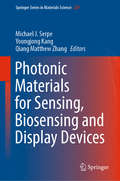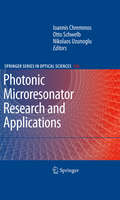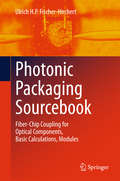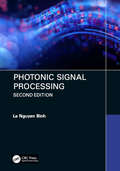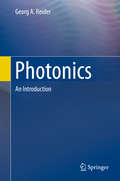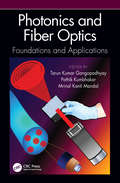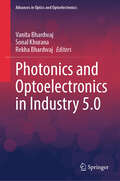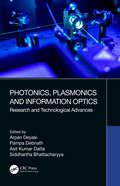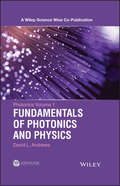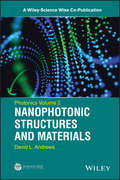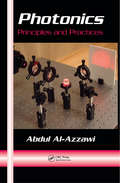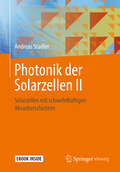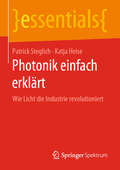- Table View
- List View
Photonic Materials for Sensing, Biosensing and Display Devices (Springer Series in Materials Science #229)
by Michael J. Serpe Youngjong Kang Qiang Matthew ZhangThis book presents the basics and applications of photonic materials. It focuses on the utility of these devices for sensing, biosensing, and displays. The book includes fundamental aspects with a particular focus on the application of photonic materials. The field of photonic materials is both a burgeoning, and mature field. There are new advances being made on a daily basis, all based on the fundamental roots set by work by those like Ozin, Thomas, Asher, and others.
Photonic Microresonator Research and Applications
by Nikolaos Uzunoglu Otto Schwelb Ioannis ChremmosThe technology surrounding the design and fabrication of optical microresonators has matured to a point where there is a need for commercialization. Consequently, there is a need for device research involving more advanced architectures and more esoteric operating principles. Photonic Microresonator Research and Applications explores advances in the fabrication process that enable nanometer waveguide separations, exceptionally smooth surfaces essential to reach Q factors in the order of 106- 108 and high index contrast materials.
Photonic Network-on-Chip Design
by Keren Bergman Aleksandr Biberman Gilbert Hendry Luca P. Carloni Johnnie ChanThis book provides a comprehensive synthesis of the theory and practice of photonic devices for networks-on-chip. It outlines the issues in designing photonic network-on-chip architectures for future many-core high performance chip multiprocessors. The discussion is built from the bottom up: starting with the design and implementation of key photonic devices and building blocks, reviewing networking and network-on-chip theory and existing research, and finishing with describing various architectures, their characteristics, and the impact they will have on a computing system. After acquainting the reader with all the issues in the design space, the discussion concludes with design automation techniques, supplemented by provided software.
Photonic Packaging Sourcebook
by Ulrich H. P. Fischer-HirchertThis book serves as a guide on photonic assembly techniques. It provides an overview of today's state-of-the-art technologies for photonic packaging experts and professionals in the field. The text guides the readers to the practical use of optical connectors. It also assists engineers to find a way to an effective and inexpensive set-up for their own needs. In addition, many types of current industrial modules and state-of-the-art applications from single fiber to multi fiber are described in detail. Simulation techniques such as FEM, BPM and ray tracing are explained in depth. Finally, all recent reliability test procedures for datacom and telecom modules are illustrated in combination with related standardization aspects.
Photonic Polymer Systems: Fundamentals: Methods, and Applications (Plastics Engineering)
by Donald L. Wise Gary E. Wnek Debra I. Trantolo Thomas M. Cooper Joseph O. Gresser"Furnishes the necessary background information, methods of characterization, and applications of optic and photonic systems based on polymers. Provides detailed tutorial chapters that offer in-depth explanations of optic and photonic fundamentals and synthesis techniques."
Photonic Sensing
by Gaozhi Xiao Wojtek J. BockA cutting-edge look at safety and security applications of photonic sensorsWith its many superior qualities, photonic sensing technology is increasingly used in early-detection and early-warning systems for biological hazards, structural flaws, and security threats. Photonic Sensing provides for the first time a comprehensive review of this exciting and rapidly evolving field, focusing on the development of cutting-edge applications in diverse areas of safety and security, from biodetection to biometrics.The book brings together contributions from leading experts in the field, fostering effective solutions for the development of specialized materials, novel optical devices, and networking algorithms and platforms. A number of specific areas of safety and security monitoring are covered, including background information, operation principles, analytical techniques, and applications. Topics include:Document security and structural integrity monitoring, as well as the detection of food pathogens and bacteriaSurface plasmon sensors, micro-based cytometry, optofluidic techniques, and optical coherence tomographyOptic fiber sensors for explosive detection and photonic liquid crystal fiber sensors for security monitoringPhotonics-assisted frequency measurement with promising electronic warfare applicationsAn invaluable, multidisciplinary resource for researchers and professionals in photonic sensing, as well as safety and security monitoring, this book will help readers jump-start their own research and development in areas of physics, chemistry, biology, medicine, mechanics, electronics, and defense.
Photonic Signal Processing, Second Edition: Techniques and Applications (Optical Science and Engineering #1)
by Le Nguyen BinhThis Second Edition of "Photonic Signal Processing" updates most recent R&D on processing techniques of signals in photonic domain from the fundamentals given in its first edition. Several modern techniques in Photonic Signal Processing (PSP) are described: Graphical signal flow technique to simplify the analysis of the photonic transfer functions, plus its insights into the physical phenomena of such processors. The resonance and interference of optical fields are presented by the poles and zeros of the optical circuits, respectively. Detailed design procedures for fixed and tunable optical filters. These filters, "brick-wall-like", now play a highly important role in ultra-broadband (100GBaud) to spectral shaping of sinc temporal response so as to generate truly Nyquist sampler of the received eye diagrams 3-D PSP allows multi-dimensional processing for highly complex optical signals Photonic differentiators and integrators for dark soliton generations. Optical dispersion compensating processors for ultra-long haul optical transmission systems. Some optical devices essentials for PSP. Many detailed PSP techniques are given in the chapters of this Second Edition.
Photonic Structures Inspired by Nature
by Mathias KolleUnlike most natural colours that are based on pigment absorption, the striking iridescent and intense colouration of many butterflies, birds or beetles stems from the interaction of light with periodic sub-micrometer surface or volume patterns, so called "photonic structures". These "structural colours" are increasingly well understood, but they are difficult to create artificially and exploit technologically. In this thesis the field of natural structural colours and biomimetic photonic structures is covered in a wide scope, ranging from plant photonics to theoretical optics. It demonstrates diffractive elements on the petal surfaces of many flowering plant species; these form the basis for the study of the role of structural colours in pollinator attraction. Self-assembly techniques, combined with scale able nanofabrication methods, were used to create complex artificial photonic structures inspired by those found in nature. In particular, the colour effect of a Papilio butterfly was mimicked and, by variation of its design motive, enhanced. All photonic effects described here are underpinned by state-of-the-art model calculations.
Photonic Waveguide Components on Silicon Substrate: Modeling and Experiments (SpringerBriefs in Applied Sciences and Technology)
by Swagata Samanta Pallab Banerji Pranabendu GangulyThis book focuses on the design and development of SU-8 polymer and silicon waveguide-based devices using the effective index based matrix method. Various fabrication techniques like laser direct writing (LDW), Focused Ion Beam (FIB) and optical lithography are discussed. FIB lithography has been explored for photonic-crystal structures on the waveguide and for directional coupler in coupled region. This technique is shown to be suitable in fabricating photonic crystal structures as well as for making any precise modifications in micro- and nano-meter photonic waveguide structures. This book can be a useful reference for students, researchers, and fabrication engineers working in the areas of integrated optics, optical communications, laser technology and optical lithography for device manufacturing.
Photonics
by Georg A. ReiderThis book provides a comprehensive introduction into photonics, from the electrodynamic and quantum mechanic fundamentals to the level of photonic components and building blocks such as lasers, amplifiers, modulators, waveguides, and detectors. The book will serve both as textbook and as a reference work for the advanced student or scientist. Theoretical results are derived from basic principles with convenient, yet state-of-the-art mathematical tools, providing not only deeper understanding but also familiarization with formalisms used in the relevant technical literature and research articles. Among the subject matters treated are polarization optics, pulse and beam propagation, waveguides, light-matter interaction, stationary and transient behavior of lasers, semiconductor optics and lasers (including low-dimensional systems such as quantum wells), detector technology, photometry, and colorimetry. Nonlinear optics are elaborated comprehensively. The book is intended for both students of physics and electronics and scientists and engineers in fields such as laser technology, optical communications, laser materials processing, and medical laser applications who wish to gain an in-depth understanding of photonics.
Photonics
by Vittorio Degiorgio Ilaria CristianiThis extended and revised edition will serve as a concise, self-contained, up-to-date introduction to Photonics for undergraduate students. It can also be used as a primer by researchers and professionals who start working in the field. Blending theory with technical descriptions, the book covers a wide range of topics, including the general mechanism of laser action, continuous and pulsed laser operation, optical propagation in isotropic and anisotropic media, operating principles and structure of passive optical components, electro-optic and acousto-optic modulation, solid-state lasers, semiconductor lasers and LEDs, nonlinear optical phenomena, and optical fiber components and devices. The book concludes with an overview of applications, including optical communications, telemetry and sensing, industrial and biomedical applications, solid-state lighting, displays, and photovoltaics. This second edition includes a set of problems at the end of all but the last chapter. These problems deal with numerical computations designed to illustrate the magnitudes of important quantities and are also intended to test the student's ability to apply theoretical formulas.
Photonics Elements for Sensing and Optical Conversions
by Nikolay L. KazanskiyThis book covers a number of a rapidly growing areas of knowledge that may be termed as diffractive nanophotonics. It also discusses in detail photonic components that may find uses in sensorics and optical transformations. Photonics Elements for Sensing and Optical Conversions, covers a number of rapidly growing areas of knowledge that may be termed as diffractive nanophotonics. The book examines the advances in computational electrodynamics and nanoelectronics that have made it possible to design and manufacture novel types of photonic components and devices boasting unique properties unattainable in the realm of classical optics. The authors discuss plasmonic sensors, and new types of wavefront sensors and nanolasers that are widely used in telecommunications, quantum informatics and optical transformations. The book also deals with the recent advances in the plasmonic sensors based on metal-insulator-metal waveguides for biochemical sensing applications. Additionally, nanolasers are examined in detail, with a focus on contemporary issues, the book also deals with the fundamentals and highly attractive applications of metamaterials and metasurfaces. The authors provide an insight into sensors based on Zernike optical decomposition using a multi-order diffractive optical element, and explore the performance advances that can be achieved with optical computing. The book is written for opticians, scientists and researchers who are interested in an interesting section of plasmonic sensors, new types of wavefront sensors and nanolasers, and optical transformations. The book will be bought by upper graduate and graduate level students looking to specialize in photonics and optics.
Photonics Modelling and Design (Optical Sciences and Applications of Light)
by Slawomir SujeckiPhotonics Modeling and Design delivers a concise introduction to the modeling and design of photonic devices. Assuming a general knowledge of photonics and the operating principles of fibre and semiconductor lasers, this book: Describes the analysis of the light propagation in dielectric media Discusses heat diffusion and carrier transport Applies the presented theory to develop fibre and semiconductor laser models Addresses the propagation of short optical pulses in optical fibres Puts all modeling into practical context with examples of devices currently in development or on the market Providing hands-on guidance in the form of MATLAB® scripts, tips, and other downloadable content, Photonics Modeling and Design is written for students and professionals interested in modeling photonic devices either for gaining a deeper understanding of the operation or to optimize the design.
Photonics and Fiber Optics: Foundations and Applications
by Tarun Kumar Gangopadhyay Pathik Kumbhakar Mrinal Kanti MandalThe combination of laser and optoelectronics with optical fiber technology can enhance the seamless activities of fiber-optic communications and fiber-sensor arena. This book discusses foundations of laser technology, non-linear optics, laser and fiber-optic applications in telecommunication and sensing fields including fundamentals and recent developments in photonics technology. Accumulated chapters cover constituent materials, techniques of measurement of non-linear optical properties of nanomaterials, photonic crystals and pertinent applications in medical, high voltage engineering and, in optical computations and designing logic gates.
Photonics and Optoelectronics in Industry 5.0 (Advances in Optics and Optoelectronics)
by Vanita Bhardwaj Sonal Khurana Rekha BhardwajThis book presents the role of photonic and optoelectronics with a focus on transformation of Industry 5.0. This book offers in-depth discussion of interfaces between human-machine collaboration. The introductory chapters discuss the fundamentals of photonics and optoelectronics as well as its use in real-time monitoring, additive manufacturing, and precision machining. Additionally, focus is placed on sustainability and energy efficiency, demonstrating how photonics may enhance industrial processes and assist renewable energy management. Finally, the book reviews the development of machine learning methods for optimization and the integration of artificial intelligence with photonic systems which are described in ample detail. In order to assist researchers those are not familiar with the subfield, each chapter starts by providing an overview of the primary concepts to be discussed.
Photonics, Plasmonics and Information Optics: Research and Technological Advances
by Siddhartha Bhattacharyya Asit Kumar Datta Arpan Deyasi Pampa DebnathThis edited volume covers technological developments and current research trends in the field of photonics, plasmonics and optics, focusing on photonic crystals, semiconductor optical devices, optical communications and optical sensors, with an emphasis on practical sectors. It broadly contains the latest research domains contributed by experts and researchers in their respective fields with a major focus on the basic physics. Works in the area of electromagnetic bandgap structures (EBG) and metasurfaces are included for applications in different aspects of communications systems. Further, it covers research phenomena of microwave photonic devices to develop miniaturized high-frequency devices. FEATURES Reviews nonlinear optical phenomena related with materials and crystals and plasmonic effects on device fabrications Contains a detailed analysis on photonic crystals with their applications in making all-optical passive components Focusses on nonlinear optics, more precisely on crystals and materials, and computational aspects on evaluating their properties from Maxwell’s equations Presents an extensive study on the physics of EBG structures for application in antenna and high-frequency communications Includes metamaterials and metasurfaces for applications in photonics as well as in microwave engineering for high-frequency communication systems Photonics, Plasmonics and Information Optics: Research and Technological Advances is aimed at researchers, professionals and graduate students in optical communication, silicon photonics, photonic crystals, semiconductor optical devices, metamaterials and metasurfaces, and microwave photonics.
Photonics, Volume 1: Fundamentals of Photonics and Physics (A Wiley-Science Wise Co-Publication)
by David L. AndrewsCovers modern photonics accessibly and discusses the basic physical principles underlying all the applications and technology of photonics.This volume covers the basic physical principles underlying the technology and all applications of photonics from statistical optics to quantum optics. The topics discussed in this volume are: Photons in perspective; Coherence and Statistical Optics; Complex Light and Singular Optics; Electrodynamics of Dielectric Media; Fast and slow Light; Holography; Multiphoton Processes; Optical Angular Momentum; Optical Forces, Trapping and Manipulation; Polarization States; Quantum Electrodynamics; Quantum Information and Computing; Quantum Optics; Resonance Energy Transfer; Surface Optics; Ultrafast Pulse Phenomena. Comprehensive and accessible coverage of the whole of modern photonics Emphasizes processes and applications that specifically exploit photon attributes of light Deals with the rapidly advancing area of modern optics Chapters are written by top scientists in their field Written for the graduate level student in physical sciences; Industrial and academic researchers in photonics, graduate students in the area; College lecturers, educators, policymakers, consultants, Scientific and technical libraries, government laboratories, NIH.
Photonics, Volume 2: Nanophotonic Structures and Materials (A Wiley-Science Wise Co-Publication)
by David L. AndrewsDiscusses the basic physical principles underlying the science and technology of nanophotonics, its materials and structures This volume presents nanophotonic structures and Materials. Nanophotonics is photonic science and technology that utilizes light/matter interactions on the nanoscale where researchers are discovering new phenomena and developing techniques that go well beyond what is possible with conventional photonics and electronics.The topics discussed in this volume are: Cavity Photonics; Cold Atoms and Bose-Einstein Condensates; Displays; E-paper; Graphene; Integrated Photonics; Liquid Crystals; Metamaterials; Micro-and Nanostructure Fabrication; Nanomaterials; Nanotubes; Plasmonics; Quantum Dots; Spintronics; Thin Film Optics Comprehensive and accessible coverage of the whole of modern photonics Emphasizes processes and applications that specifically exploit photon attributes of light Deals with the rapidly advancing area of modern optics Chapters are written by top scientists in their field Written for the graduate level student in physical sciences; Industrial and academic researchers in photonics, graduate students in the area; College lecturers, educators, policymakers, consultants, Scientific and technical libraries, government laboratories, NIH.
Photonics, Volume 3: Photonics Technology and Instrumentation (A Wiley-Science Wise Co-Publication)
by David L. AndrewsDiscusses the basic physical principles underlying the technology instrumentation of photonics This volume discusses photonics technology and instrumentation. The topics discussed in this volume are: Communication Networks; Data Buffers; Defense and Security Applications; Detectors; Fiber Optics and Amplifiers; Green Photonics; Instrumentation and Metrology; Interferometers; Light-Harvesting Materials; Logic Devices; Optical Communications; Remote Sensing; Solar Energy; Solid-State Lighting; Wavelength Conversion Comprehensive and accessible coverage of the whole of modern photonics Emphasizes processes and applications that specifically exploit photon attributes of light Deals with the rapidly advancing area of modern optics Chapters are written by top scientists in their field Written for the graduate level student in physical sciences; Industrial and academic researchers in photonics, graduate students in the area; College lecturers, educators, policymakers, consultants, Scientific and technical libraries, government laboratories, NIH.
Photonics, Volume 4: Biomedical Photonics, Spectroscopy, and Microscopy (A Wiley-Science Wise Co-Publication)
by David L. AndrewsDiscusses the basic physical principles underlying Biomedical Photonics, spectroscopy and microscopy This volume discusses biomedical photonics, spectroscopy and microscopy, the basic physical principles underlying the technology and its applications. The topics discussed in this volume are: Biophotonics; Fluorescence and Phosphorescence; Medical Photonics; Microscopy; Nonlinear Optics; Ophthalmic Technology; Optical Tomography; Optofluidics; Photodynamic Therapy; Image Processing; Imaging Systems; Sensors; Single Molecule Detection; Futurology in Photonics. Comprehensive and accessible coverage of the whole of modern photonics Emphasizes processes and applications that specifically exploit photon attributes of light Deals with the rapidly advancing area of modern optics Chapters are written by top scientists in their field Written for the graduate level student in physical sciences; Industrial and academic researchers in photonics, graduate students in the area; College lecturers, educators, policymakers, consultants, Scientific and technical libraries, government laboratories, NIH.
Photonics: A Short Course (Undergraduate Lecture Notes in Physics)
by Vittorio Degiorgio Ilaria CristianiThis book will serve as a concise, self-contained, up-to-date introduction to Photonics, to be used as a textbook for undergraduate students or as a reference book for researchers and professionals. Blending theory with technical descriptions, the book covers a wide range of topics, including the general mechanism of laser action, continuous and pulsed laser operation, optical propagation in isotropic and anisotropic media, operating principles and structure of passive optical components, electro-optical and acousto-optical modulation, solid-state lasers, semiconductor lasers and LEDs, nonlinear optics, and optical fiber components and devices. The book concludes with an overview of applications, including optical communications, telemetry and sensing, industrial and biomedical applications, solid-state lighting, displays and photovoltaics.
Photonics: Principles and Practices (Optical Science and Engineering #123)
by Abdul Al-Azzawi<p>Since the invention of the laser, our fascination with the photon has led to one of the most dynamic and rapidly growing fields of technology. An explosion of new materials, devices, and applications makes it more important than ever to stay current with the latest advances. Surveying the field from fundamental concepts to state-of-the-art developments, Photonics: Principles and Practices builds a comprehensive understanding of the theoretical and practical aspects of photonics from the basics of light waves to fiber optics and lasers. Providing self-contained coverage and using a consistent approach, the author leads you step-by-step through each topic. <p>Each skillfully crafted chapter first explores the theoretical concepts of each topic and then demonstrates how these principles apply to real-world applications by guiding you through experimental cases illuminated with numerous illustrations. Coverage is divided into six broad sections, systematically working through light, optics, waves and diffraction, optical fibers, fiber optics testing, and laboratory safety. A complete glossary, useful appendices, and a thorough list of references round out the presentation. <p>The text also includes a 16-page insert containing 28 full-color illustrations. Containing several topics presented for the first time in book form, Photonics: Principles and Practices is simply the most modern, comprehensive, and hands-on text in the field.</p>
Photonik der Solarzellen II: Solarzellen Mit Schwefelhaltigen Absorberschichten
by Andreas StadlerSpezielle potentielle Absorber-Material-Konzepte werden vorgestellt. und diskutiert. Experimentell ermittelte Parameter son Solarzellen mit schwefelhaltigen Absorberschichten sind besprochen sowie unterschiedlichen Puffer- und Zwischenschichten (z. B. CdS, i-ZnO:Al, Bi2S3) und deren Einfluss auf die Funktion von Solarzellen. Konzentrations-Variationen unterschiedlicher Elemente (z.B. Sn, Pb, Bi, Sb, Cu, S) und typischen Sputter-Parametern auf die physikalischen Werte der untersuchten Dünnschichten können nachvollzogen werden.
Photonik einfach erklärt: Wie Licht die Industrie revolutioniert (essentials)
by Patrick Steglich Katja HeiseWir befinden uns am Scheideweg einer neuen Epoche: Das Zeitalter der Elektronik wird abgelöst vom Zeitalter der Photonik. Dieses Buch führt Sie in die faszinierende Entwicklung der Photonik ein und verzichtet dabei auf komplizierte Fachsprache, vielmehr werden die physikalischen Grundlagen anschaulich erklärt. Darauf aufbauend werden wichtige Entwicklungen wie zum Beispiel der Laser und dessen Anwendungen in der Industrie, Forschung und im Alltag beschrieben. Komplizierte physikalische Eigenschaften und technische Details werden dem Leser in verständlicher Art und Weise erklärt.Die Autoren:Dr. Patrick Steglich ist Dozent für Photonik und optische Technologien an der Technischen Hochschule Wildau und Wissenschaftler am Leibniz-Institut für innovative Mikroelektronik IHP in Frankfurt (Oder). Katja Heise arbeitet als Redakteurin in Berlin. Als gelernte Politologin und Journalistin hat sie sich darauf spezialisiert, komplexe Fachthemen in einfache Sprache zu übersetzen. Die Autoren leben gemeinsam mit ihrem Sohn und ihren zwei Töchtern in Berlin.
Photons Nonlinear Optics
by D.N. KlyshkoThis book provides an introduction to quantum optics for experimental physicists and for college students who have studied quantum mechanics. Its distinguishing feature is its emphasis on multimode fields with correlating different-frequency modes, notably on their phenomenological description and on the practical methods of generating them. The phenomena described in this book provide an opportunity to study nonrelativistic quantum electrodynamics and to master many important concepts of theoretical physics.
